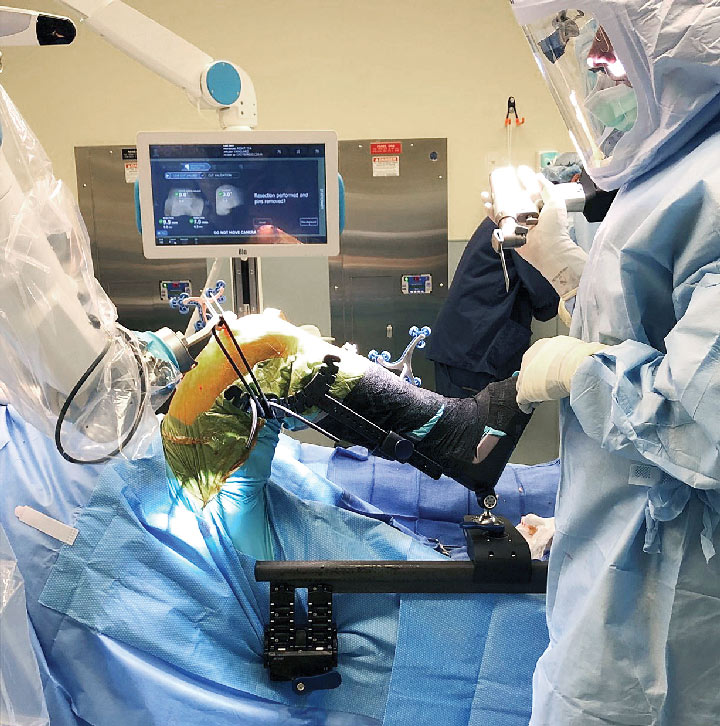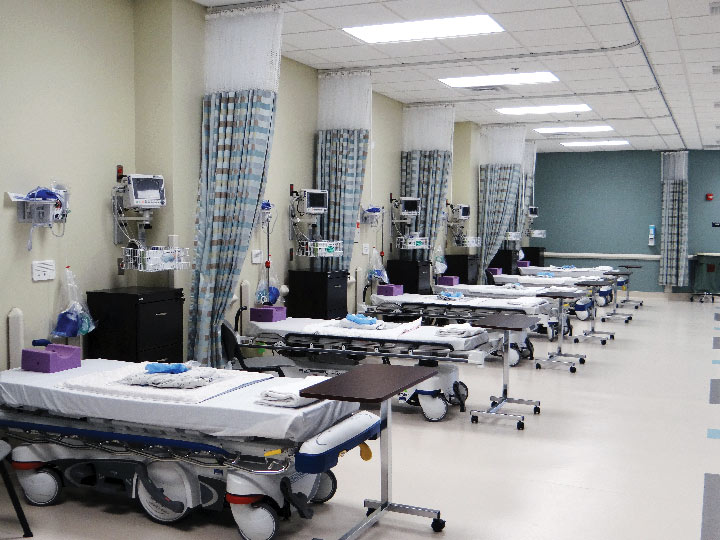- Home
- Special Editions
- Article
Outfitting for the Outpatient Ortho Boom
By: Carol Katarsky | Contributing Editor
Published: 3/16/2023
To capitalize on the surging market, design your facility with convenience and efficiency in mind.
Between aging Baby Boomers’ growing needs and a strong same-day preference among patients and insurers, the demand for outpatient orthopedic procedures like total knees and total hips is at fever pitch right now — and everyone’s looking to cash in. But success in the outpatient ortho space ultimately comes down to leadership that meets the design, equipment and staffing challenges of this competitive service line head-on.
Patient-centered design
Convenience is a crucial design component of success. Chris Bailey, PT, DPT, OCS, chief development officer for Revo Health in Golden Valley, Minn., says everything about the surgical experience should be viewed from the patients’ perspective — starting with the physical design of the facility. For instance, when Dr. Bailey and his team opened the 76,000-square-foot Twin Cities Orthopedics Full-Service Orthopedic Center in Eagan, Minn., (also known as TCO Eagan — Viking Lakes) in 2018, the goal to provide an all-in-one approach to orthopedic care, with a surgery center, advanced imaging, PT and more — all under one roof.
Revo has taken that same blueprint it used for the successful TCO Eagan launch and applied to a brand-new project slated for a tiered opening starting this fall: A three-story, 70,000-square-foot facility that will house all the orthopedic services patients may need, including a surgery center (opening in early 2024), urgent care, physical therapy, advanced MRI imaging scanners and private care suites.
“Having a one-stop shop is important to the consumer because of the ease of access to high-quality health care,” says Dr. Bailey. “We see having the surgery center attached to the clinic, the care suites and all the postoperative therapy in one spot as a real driver of convenience for patients.” Of course, location often plays a pivotal role in the success or downfall of any new ortho facility as well. That’s why all Revo’s facilities are carefully chosen to meet both procedural demand and to increase patient comfort. Located in a town just 10 miles from Minneapolis, Dr. Bailey says that suburban patients can access Revo’s new facility via familiar roads and without going into the city, which can make the experience better for patients and logistically easier for family caregivers.
Many aspects of new buildings — from where they’re located, the design of procedure rooms, co-locating complementary services and more — can be used strategically to make these facilities more efficient for surgical teams and improve the overall patient experience. While patients and their needs were at the center of Revo’s design process, ensuring workers’ needs were met was also an important consideration. “We know we cannot deliver the highest level of patient care without a highly engaged staff,” says Dr. Bailey. To that end, the building was designed with wider hallways, brighter corridors, more windows in the staff break areas and even access to employee-only outdoor areas for when staffers need to take a breather on a rough day. “These things all add up to a more satisfied staff and the patient is the one who benefits,” says Dr. Bailey. “I also think that competition in the market is important. As we build new facilities, the bar is raised for competitors’ new facilities, and when the bar is raised, ultimately, the patient wins.”
Devil is in the details

When you’re in the thick of designing a new facility and watching the budget expand, it’s tempting to forgo certain features that may not seem essential. But those are the things that often pay dividends down the road in terms of patient and staff satisfaction.
For instance, when Adolph Lombardi, MD, FACS, and his team were well into the planning for White Fence Surgical Suites ASC in New Albany, Ohio, stakeholders thought about the harsh Ohio winters and the seasonal rainstorms. “When we decided to add a drive-through portico outside of our doors, we were thinking about the convenience of not having to trudge through the rain or the snow in the parking lot,” says Dr. Lombardi, president of JIS Orthopedics, the practice that runs White Fence ASC.
Dr. Lombardi also understands the space constraints surgery centers often face. That’s why leaders were uber-efficient when it came time to put together the layout of his surgery center, with an emphasis on avoiding redundancy. One prime example is the seven pre-op bays that also serve as the PACU for patients prior to their discharges so there’s no wasted space in the 7,500 square-foot surgery center. Dr. Lombardi says newer facilities tend to want to build bigger than their needs, which leads to more staff, equipment and extra, often under-utilized, rooms. “Why open your center with four to six ORs if you aren’t 100% sure they will always be in use?” he asks. “We have two ORs and a procedure room and everything is always running.”
With just two ORs, Dr. Lombardi and his team have managed to do more than 14,500 total joints cases over the last decade, with 1,750 cases in the last year alone.
Surgeon sit-downs

As important as the design of your center is, it’s your staff that ultimately dictates the success of your orthopedic offerings. Whether you’re creating a brand-new orthopedic center or simply expanding your current services, you need to get your surgeons on the same page from day one. The best way to do it? Getting your doctors together and going through everything from the minute details of their instrumentation and implant preferences to the 30,000-foot strategy for the center.
That’s a critical piece of advice Dr. Lombardi offers to surgical leaders looking to capitalize on the outpatient orthopedic boom we’re in right now. “Get all of the key players, all your doctors, in a room together and find out what makes them tick,” he says. “Look at the implant preferences and the basic instrumentation needed to run a program.” More than a decade ago, Dr. Lombardi did this at White Fence, when he gathered the surgeons and looked at every one of the basic instruments they’d be using to do total joints and said Yay or Nay to each. “Streamlining instrumentation is crucial,” he says. “If you’re doing hips, you don’t need every reamer. Open one size up and one size down from what you need to do the case.”
Diane Doucette, president and COO at Mount Carmel New Albany and Mount Carmel St. Ann’s, strongly agrees with Dr. Lombardi on the importance of efficiency and reduced waste, adding that timing is another crucial component of building a successful center. “Timing is everything at ASCs and you have to look at efficiency every step of the way,” she says. “If you’re doing 10 total joint cases a day, you need at least six sets of instruments and then you have to factor in the processing time, which is around two hours.”
Ms. Doucette’s attention to detail carries over to the patient education side of things, an area she believes is of critical importance to any successful total joints program. “When we do pre-op education, we tell the patients and their caregivers, ‘You’re going to be here for five hours, and then we explain everything that happens during that time,” she says.
If you’re unsure or still have lingering questions about the intricacies of running a facility, Dr. Lombardi says the best thing to do is see the show in action. “Pick a site, then go and visit,” he says, adding that it’s essential to bring the right group with you. “You want to bring a key surgeon, a pre-op and PACU nurse, an anesthesiologist and, of course, an administrator,” he says. “That way the administrator can see what the administrator over there is worried about and the anesthesiologist can see if they’ll be comfortable doing blocks in a pre-op area.”
Timing is everything at ASCs and you have to look at efficiency every step of the way.
Diane Doucette
Positioned for success
Key players like Dr. Lombardi, Ms. Doucette and Dr. Bailey understand what an exciting time it is to be in the orthopedic space and have positioned themselves and their facilities accordingly. “We have to keep up with that market demand,” says Dr. Bailey. “We anticipate that demand for ortho procedures will be like a tsunami over the next 10-plus years. Our newest facility gives us a much stronger presence in a market we’re already serving.”
Of course, that means providing an exceptional experience for every patient they care for. “Joint replacement surgery has become very common, but when it’s you or your family member going through it, it’s a big deal and it’s stressful,” he says. “Anything we can do to reduce stress on the patient and the family by making health care a little easier to navigate is important.” OSM
.svg?sfvrsn=be606e78_3)
.svg?sfvrsn=56b2f850_5)